Submitted:
28 November 2023
Posted:
29 November 2023
You are already at the latest version
Abstract
Keywords:
1. Introduction
2. Materials and methods
2.2. Study area description
2.3. Data collection
2.3.1. Vegetation data collection
2.4. Data analysis
2.4.1. Vegetation data analysis
2.4.2. Floristic similarity analysis between land use types
2.4.3. Spatial data analysis
3. Result
3.1. Exotic plant species in Gullele Botanic Garden
3.2. Exotic species abundance and density in different land use types
3.1. Exotic and invasive/potential invasive species diversity in different land use types
3.2. Floristic similarity analysis between land use types
3.2.1. Invasive species in Gullele Botanic Garden
3.1.2. Invasive species distribution and land use types
3.3. Special distribution Exotic species in the garden
Discussion
3.4. Exotic plant species in Gullele Botanic Garden
3.5. Species abundance, density and diversity in the sampled use types
3.6. Spatial distribution Exotic species in the garden
3.7. Invasive species distribution and land use types
Conclusion
Funding
Institutional Review Board Statement
Data Availability Statement
Acknowledgments
Conflicts of Interest
Appendix 1: list of exotic species
| No. | Species Name | Family | Habit | Status invasiveness |
| 1 | Acacia decurrens Willd. | Fabaceae | T | PI |
| 2 | Acacia mearnsii De Wild. | Fabaceae | T | PI |
| 3 | Acacia melanoxylon R. Br. | Fabaceae | T | I |
| 4 | Acacia saligna (Labill.) Wendl. | Fabaceae | S | I |
| 5 | Agapanthus africanus T.Durand and Schinz | Agapanthaceae | H | NI |
| 6 | Agave americana L. | Agavaceae | S | NI |
| 7 | Agave sisalana Perro ex Eng. | Agavaceae | S | NI |
| 8 | Aloysia triphylla (L’Herit.) Britton | Verbenaceae | S | NI |
| 9 | Aptenia cordifolia (Tenore) V. Steenis | Aizoaceae | H | NI |
| 10 | Araucaria heterophylla (Salisb.) Franco | Araucariaceae | T | NI |
| 11 | Argemone mexicana L. | Papaveraceae | H | I |
| 12 | Arundo donax L. | Poaceae | H | NI |
| 13 | Azadirachta indica A. Juss. | Meliaceae | T | NI |
| 14 | Bougainvillea glabra | Nyctaginaceae | S/C | NI |
| 15 | Callistemon citrinus (Curtis) Skeels. | Myrtaceae | T | NI |
| 16 | Callistephus chinensis (L.) Nees | Asteraceae | H | NI |
| 17 | Carica papaya L. (Caricaceae). | Caricaceae | T | NI |
| 18 | Carpobrotus edulis (L.) L. Bolus | Aizoaceae | H | NI |
| 19 | Centradenia floribunda shawl | Melastomataceae | H | NI |
| 20 | Chlorophytum comosum (Thunb.) Jacques | Asparagaceae | H | NI |
| 21 | Chrysanthemum leucanthemum L. | Asteraceae | H | NI |
| 22 | Citrus aurantiifolia (Christm.) Swingle | Rutaceae | S | NI |
| 23 | Cordyline australis (G.Forst.) Endl. | Asparagaceae | T | NI |
| 24 | Cordyline fruticosa (L.) A.Chev. | Asparagaceae | H | NI |
| 25 | Crassula ovata (Miller) Druce | Crassulaceae | H | NI |
| 26 | Cuphea hyssopifolia Kunth | Lythraceae | H | NI |
| 27 | Cuphea ignea A.DC | Lythraceae | H | NI |
| 28 | Cuphea micropetala Kunth | Lythraceae | H | NI |
| 29 | Cupressus lusitanica Mill | Cupressaceae | T | NI |
| 30 | Cuscuta campestris Yuncker | Cuscutaceae | H | I |
| 31 | Cyathula uncinulata (Schrad.) Schinz* | Commelinaceae | H | I |
| 32 | Cymbopogon citratus (DC.) Stapf. | Poaceae | H | NI |
| 33 | Dianthus barbatus L. | Caryophyllaceae | H | NI |
| 34 | Distictis buccinatoria (DC.) A.H. | Bignoniaceae | HC | NI |
| 35 | Duranta erecta L. | Verbenaceae | S | NI |
| 36 | Duranta repens L. | Verbenaceae | S | NI |
| 37 | Eucalyptus camaldulensis Dehnh. | Myrtaceae | T | NI |
| 38 | Eucalyptus citriodora Hook. | Myrtaceae | T | NI |
| 39 | Eucalyptus globulus Labill. | Myrtaceae | T | NI |
| 40 | Euonymus fortunei (Turcz.) Hand.-Mazz. | Celastraceae | S | NI |
| 41 | Euphorbia milii Des Moulins | Euphorbiaceae | S | NI |
| 42 | Ficus benjamina Linn. | Moraceae | S | NI |
| 43 | Galinsoga parviflora Cav. | Asteraceae | H | I |
| 44 | Grevillea robusta R.Br. | Proteaceae | T | NI |
| 45 | Hibiscus rosa-sinensis L. | Malvaceae | S | NI |
| 46 | Hydrangea macrophylla (Thunb.) Ser. | Hydrangeaceae | H | NI |
| 47 | Iresine herbstii Lindl. | Amaranthaceae | H | NI |
| 48 | Jacaranda mimosifolia D.Don | Bignoniaceae | T | NI |
| 49 | Jatropha curcas L. | Euphorbiaceae | T | NI |
| 50 | Lantana camara L. | Verbenaceae | S | I |
| 51 | Lavandula angustifolia Mill. | Lauraceae | S | NI |
| 52 | Ligustrum vulgare L. | Oleaceae | S | NI |
| 53 | Malus domestica Borkh. | Rosaceae | S | NI |
| 54 | Mangifera indica L. | Anacardiaceae | T | NI |
| 55 | Melaleuca alternifolia Cheel. | Myrtaceae | T | NI |
| 56 | Moringa oleifera Lam. | Moringaceae | T | NI |
| 57 | Nerium oleander L. | Apocynaceae | S | I |
| 58 | Nicotiana glauca Graham | Solanaceae | S | I |
| 59 | Opuntia ficus-indica (L.) Miller. | Cactaceae | S | NI |
| 60 | Orobanche minor Smith | Orobanchaceae | H | NI |
| 61 | Osteospermum fruticosum (L.) Norl. | Asteraceae | H | NI |
| 62 | Pelargonium asperum Willd. | Geraniaceae | H | NI |
| 63 | Pelargonium zonale (L.) L’Hér. | Geraniaceae | H | NI |
| 64 | Persea americana Mill. | Lauraceae | T | NI |
| 65 | Phalaris arundinacea L. | Poaceae | H | NI |
| 66 | Pinus patula Schiede ex Schltdl. & Cham. | Pinaceae | T | NI |
| 67 | Psidium guajava L. | Myrtaceae | S | I |
| 68 | Ricinus communis L. * | Euphorbiaceae | S | I |
| 69 | Rosa pendulina L. | Rosaceae | S | NI |
| 70 | Schinus molle L. | Anacardiaceae | T | NI |
| 71 | Senecio cineraria | Asteraceae | H | NI |
| 72 | Senna didymobotrya (Fresen.) Irwin & Barneby * | Fabaceae | S | I |
| 73 | Silybum marianum (L.) Gaertn. | Asteraceae | H | NI |
| 74 | Striga gesnerioides (Willd.) Vatke * | Scrophulariaceae | H | I |
| 75 | Tagetes minuta L. | Asteraceae | H | NI |
| 76 | Tibouchina urvilleana (DC.) Cogn. | Melastomataceae | T | NI |
| 77 | Tradescantia pallida (Rose) Hunt | Commelinaceae | H | NI |
| 78 | Vinca major L. | Apocynaceae | HC | NI |
| 79 | Vitis vinifera L. | Vitaceae | WC | NI |
| 80 | Washingtonia filifera (Linden ex Andre) H. Wendl. | Arecaceae | S | NI |
| Habit: T= Tree, S= Shrub, H= Herb, Herbacious climber, WH= woody herb, WC=Woody climber; Status invasiveness: I = Invasive, PI = potentially invasive, NI = Not invasive, * non-exotic species but included because of their invasive feature. Sources [10,29,35]. | ||||
References
- Argaw, T. Opportunities of Botanical Garden in Environmental and Development Education to Support School Based Instruction in Ethiopia. Journal of Biology, Agr. Healthca. 2015, 5(15)92-110.
- Ascensão, F.; Capinha, C. Aliens on the move: Transportation networks and non-native species. Railway ecol. 2017, 65–80. [Google Scholar]
- Burgiel, S.W.; Muir, A.A. Invasive species, climate change and ecosystem-based adaptation: addressing multiple drivers of global change, 2010.
- Carwardine, M. Alien species: what they are and why they are such a threat. Discover wildlife: From the team at BBC Wildlife Magazine, 2017.
- Castro-Díez, P.; Vaz, A.S.; Silva, J.S.; Van Loo, M.; Alonso, Á.; Aponte, C.; Bayón, Á.; Bellingham, P.J.; Chiuffo, M.C.; DiManno, N.; Julian, K. Global effects of non-native tree species on multiple ecosystem services. Biol. Revie 2019, 94, 1477–1501. [Google Scholar] [CrossRef] [PubMed]
- D’Antonio, C.; Levine, J.; Thomsen, M. Ecosystem resistance to invasion and the role of propagule supply: a California perspective. J. Medit. Ecoy. 2001, 2, 233–246. [Google Scholar]
- Castri, D. History of biological invasions with special emphasis on the Old World. Biological invasions: a global perspective, 1989, pp.1-30. Available online: https://cir.nii.ac.jp/crid/1572543025638845952.
- Ellenberg D, Mueller-Dombois D. Aims and methods of vegetation ecology. New York: Wiley, 1974.
- Engels JM, Hawkes JG, Worede M, editors. Plant genetic resources of Ethiopia. Cambridge University Press, 1991. [CrossRef]
- Fessehaie, R.; Tessema, T. Alien plant species invasions in Ethiopia: challenges and responses. In Proceedings of the International Workshop on Parthenium Weed in Ethiopia, 2014. Available online: https://ipmil.cired.vt.edu/wp-content/uploads/2014/07/10-Fessehaie.pdf.
- Gullele Botanic Garden. Organization’s website. 2022. Available online: https://gullelebotanicgarden.yolasite.com/more-info.php#! (accessed on 18 October 2023).
- Haber, E.; Network, A. Guide to monitoring exotic and invasive plants. Environment Canada, 1997.
- Hobbs, H.A. Invasive species in a changing world. Island press, 2000.
- Kent, M. Vegetation description and data analysis: a practical approach. 2nd ed. John Wiley & Sons, New York, 2012.
- Kolar, C.S.; Lodge, D.M. Progress in invasion biology: predicting invaders. Trend. Ecol. & evol. 2001, 16(4), 199-204. [CrossRef]
- Krishnan, S.; Novy, A. The role of botanic gardens in the twenty-first century. CABI Revi. 2017, 15, 1–10. [Google Scholar] [CrossRef]
- Kueffer, C.; Lavergne., C. Case studies on the status of invasive woody plant species in the Western Indian Ocean. 4. Réunion. Forest Health and Biosecurity Working Paper. 2004, (4-4E). Available online: https://www.cabdirect.org/cabdirect/abstract/20123338434.
- Kumar, A.; Prasad, S. Threats of invasive alien plant species. Int. Res.h J. Manag.t Sci. Tech. 2014, 4, 605–624. [Google Scholar]
- Mokotjomela, T.M.; Rahlao, S.J.; Vukeya, L.R.; Baltzinger, C.; Mangane, L.V.; Willis, C.K.; Mutshinyalo, T.M. The Diversity of Alien Plant Species in South Africa’s Nat. Bot. Zoolog. Gard. Div. 2023, 15, 407. [Google Scholar] [CrossRef]
- Morton, W.H. Geological Map of Addis Ababa. Addis Ababa University. Geology Department, Addis Ababa, Ethiopia, 1974.
- Moyo, H.P.; Fatunbi, A.O. Utilitarian perspective of the invasion of some South African biomes by Acacia mearnsii. Glob. J. Env. Res. 2010, 4, 6–17. [Google Scholar]
- Ellenberg, D.; Mueller-Dombois, D. Aims and methods of vegetation ecology. New York: Wiley, 1974.
- R Development Core Team. R: a language and environment for statistical computing. Vienna: R Foundation for Statistical Computing. 2021. Available online: http:// www.R-project.org/ (accessed on 10 August 2023).
- Pagad, S.; Genovesi ,P.; Carnevali, L.; Scalera, R.; Clout, M. IUCN SSC Invasive Species Specialist Group: invasive alien species information management supporting practitioners, policy makers and decision takers, 2015. Available online: https://researchspace.auckland.ac.nz/handle/2292/33532.
- Pyšek, P.; Richardson, D.M.; Rejmánek, M.; Webster, G.L.; Williamson, M.; Kirschner, J. Alien plants in checklists and floras: towards better communication between taxonomists and ecologists. Taxon. 2004, 53, 131–43. [Google Scholar] [CrossRef]
- Richardson, D.M.; Binggeli, P.; Schroth, G. Invasive agroforestry trees: problems and solutions. Agrof. Biod. Conserv. Trop. lands. 2004, 371–96. [Google Scholar]
- Richardson, D.M.; Pyšek, P.; Rejmanek, M.; Barbour, M.G.; Panetta, F.D.; West, C.J. Naturalization and invasion of alien plants: concepts and definitions. Diver distrib. 2000, 6(2), 93–107. [Google Scholar] [CrossRef]
- Seta, T.; Belay, B. BOTANIC GARDEN PROFILE Gullele Botanic Garden, Addis Ababa (Ethiopia): Current status, Challenges and Opportunities. Sibbaldia: Inter. J. Botan. Gard. Horti. 2022, 13–34. [Google Scholar] [CrossRef]
- Shiferaw, W.; Demissew, S.; Bekele, T. Invasive alien plant species in Ethiopia: ecological impacts on biodiversity a review paper. Int J Mol Biol. 2018, 3(4), 171–178. [Google Scholar] [CrossRef]
- Tadesse, M. Flora of Ethiopia and Eritrea. Addis Ababa, Ethiopia Uppsala, Sweden, 2004.
- Thomas, G.; Sucher, R.; Wyatt, A.; Jiménez, I. Ex situ species conservation: Predicting plant survival in botanic gardens based on climatic provenance. Biol. Conser. 2022, 265, 109410. [Google Scholar] [CrossRef]
- Van Kleunen, M.; Essl, F.; Pergl, J.; Brundu, G.; Carboni, M.; Dullinger, S.; Early, R.; González-Moreno, P.; Groom, Q.J.; Hulme, P.E.; Kueffer, C. The changing role of ornamental horticulture in alien plant invasions. Biol. Rev. 2018, 93, 1421–1437. [Google Scholar] [CrossRef] [PubMed]
- Vukeya, L.R.; Baltzinger, C. ; Mutshinyalo; T.M. The Diversity of Alien Plant Species in South Africa’s National Botanical and Zoological Gardens, 2023.
- Wassie, S.B. Natural resource degradation tendencies in Ethiopia: a review. Env. Syst. res. 2020, 9, 1–29. [Google Scholar] [CrossRef]
- Witt, A.; Beale, T.; Van Wilgen, B.W. An assessment of the distribution and potential ecological impacts of invasive alien plant species in eastern Africa. Transa. Royal Soc. Sout. Afr. 2018, 73, 217–236. [Google Scholar] [CrossRef]
- Wondafrash, M.; Wingfield, M.J.; Wilson, J.R.; Hurley, B.P.; Slippers, B.; Paap, T. Botanical gardens as key resources and hazards for biosecurity. Biodiversity and Conser. 2021, 30, 1929–1946. [Google Scholar] [CrossRef]
- Zhang, X.; Wang, Y.; Peng, P.; Wang, G.; Zhao, G.; Zhou, Y.; Tang, Z. Mapping the distribution and dispersal risks of the alien invasive plant Ageratina adenophora in China. Diver. 2022, 14, 915. [Google Scholar] [CrossRef]
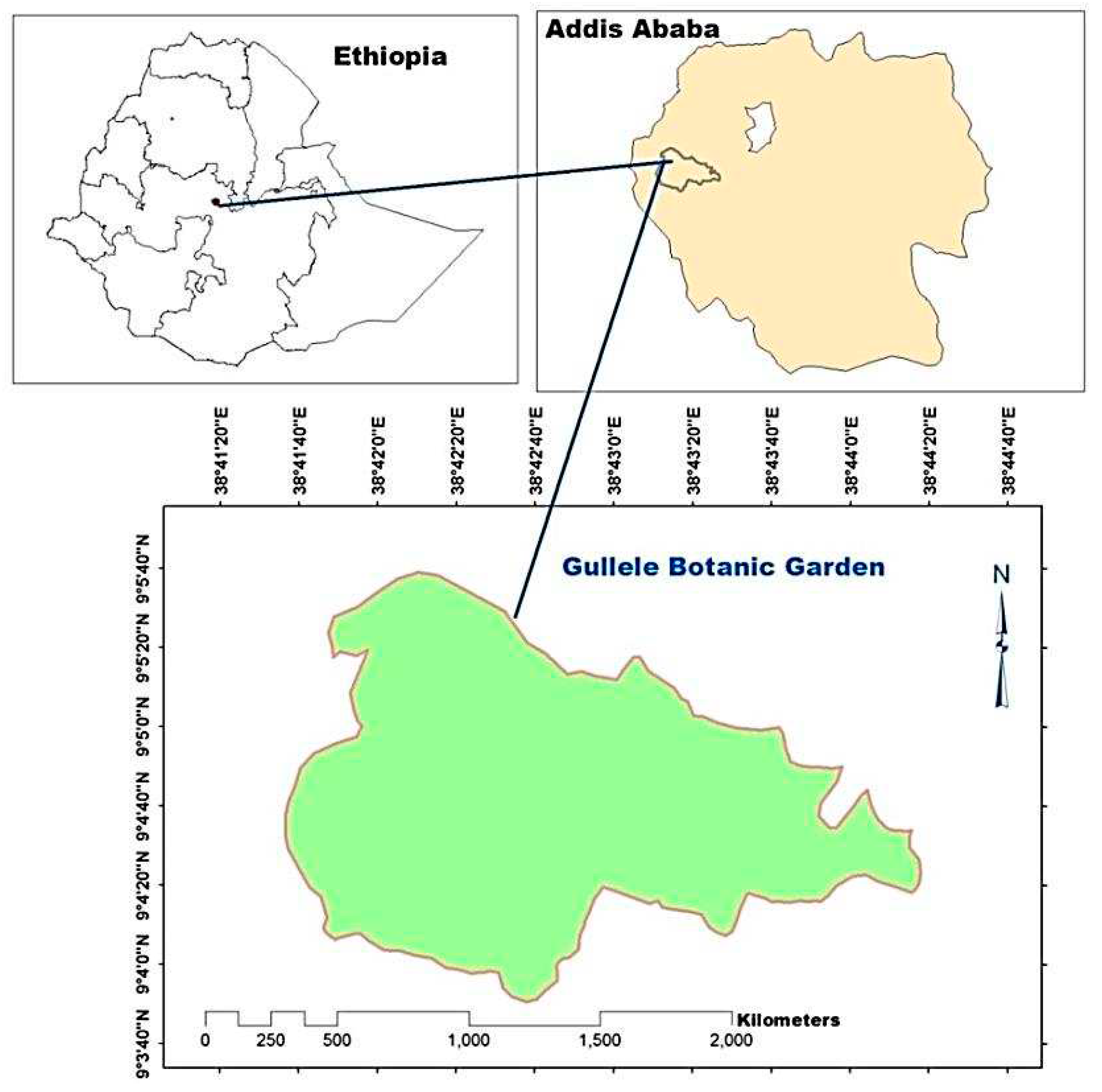
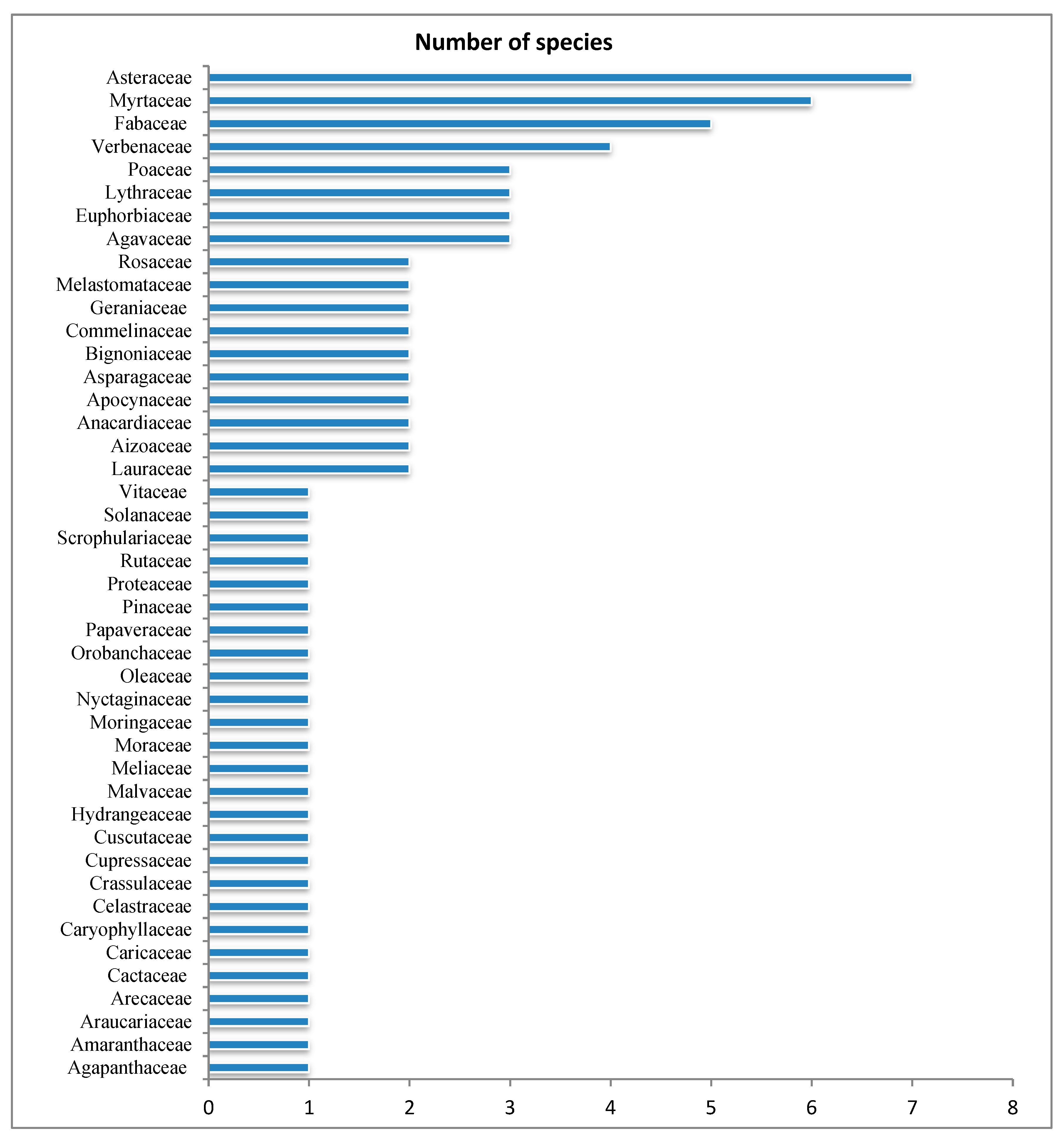
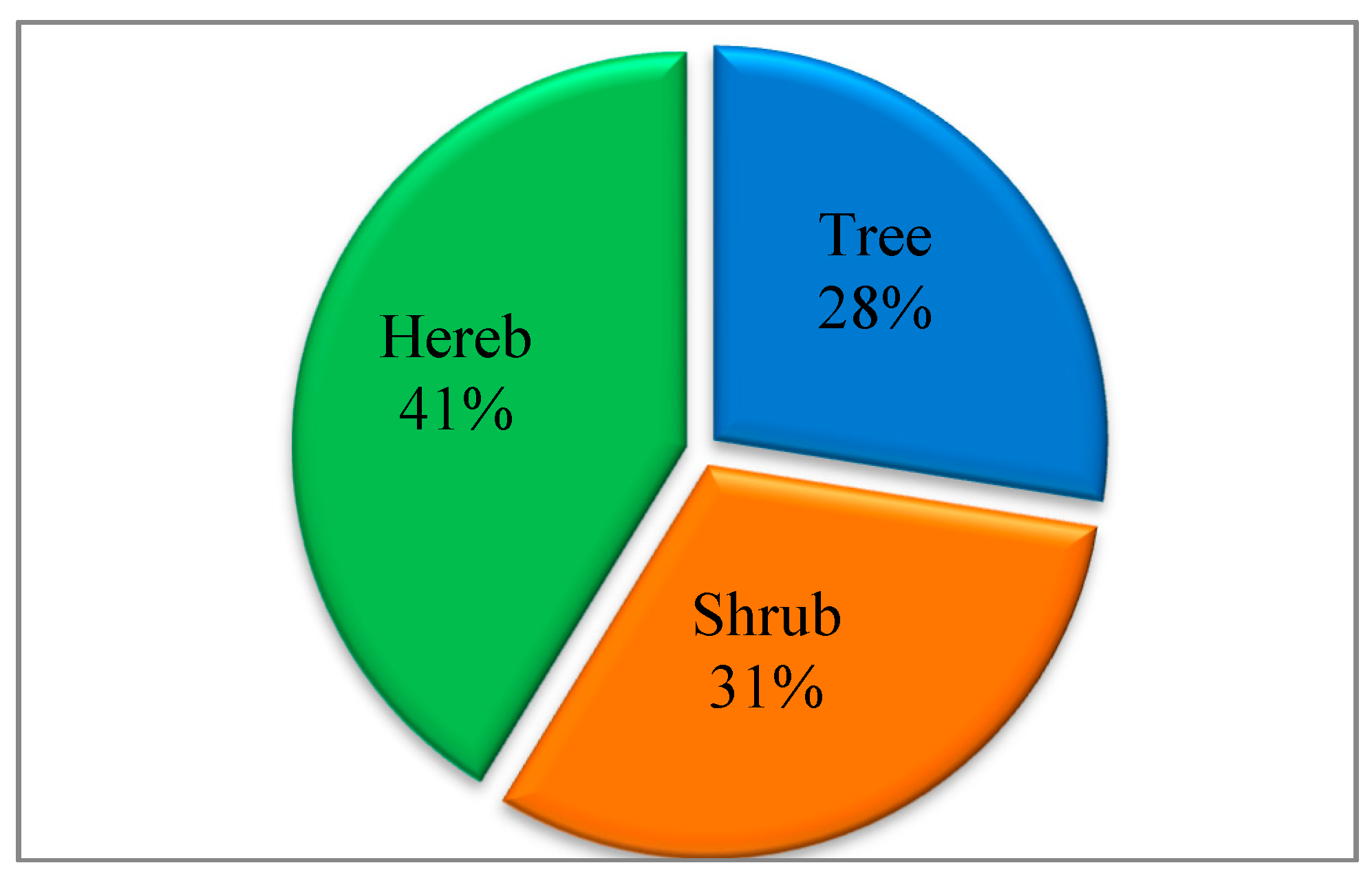
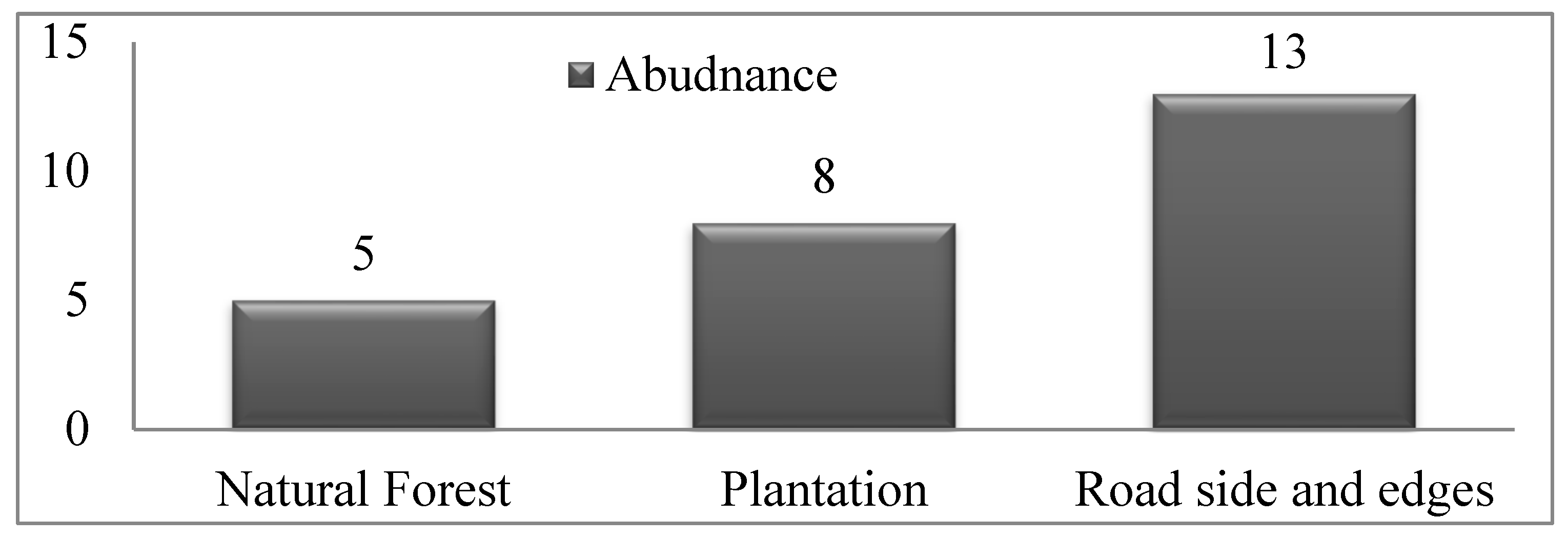
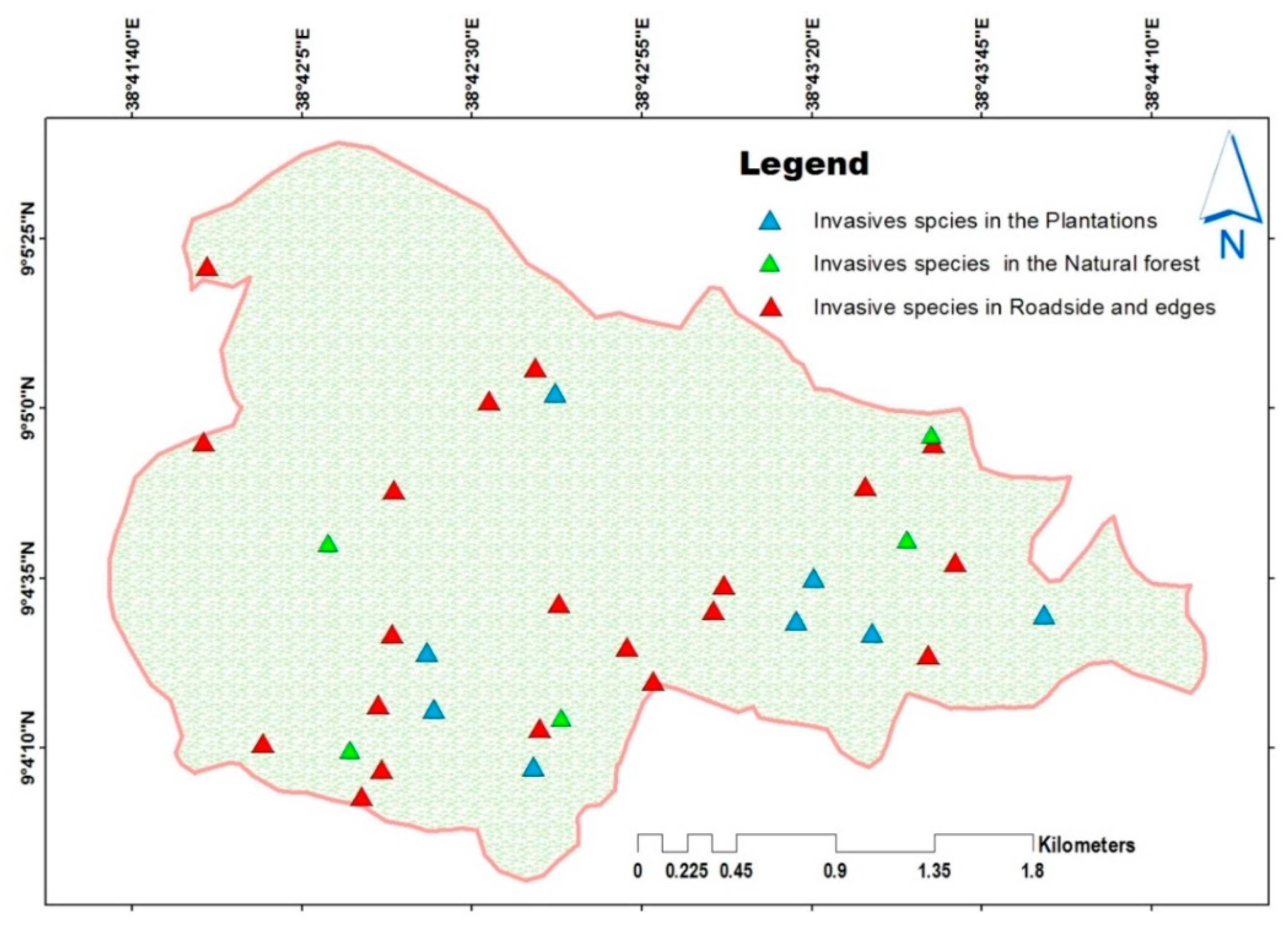
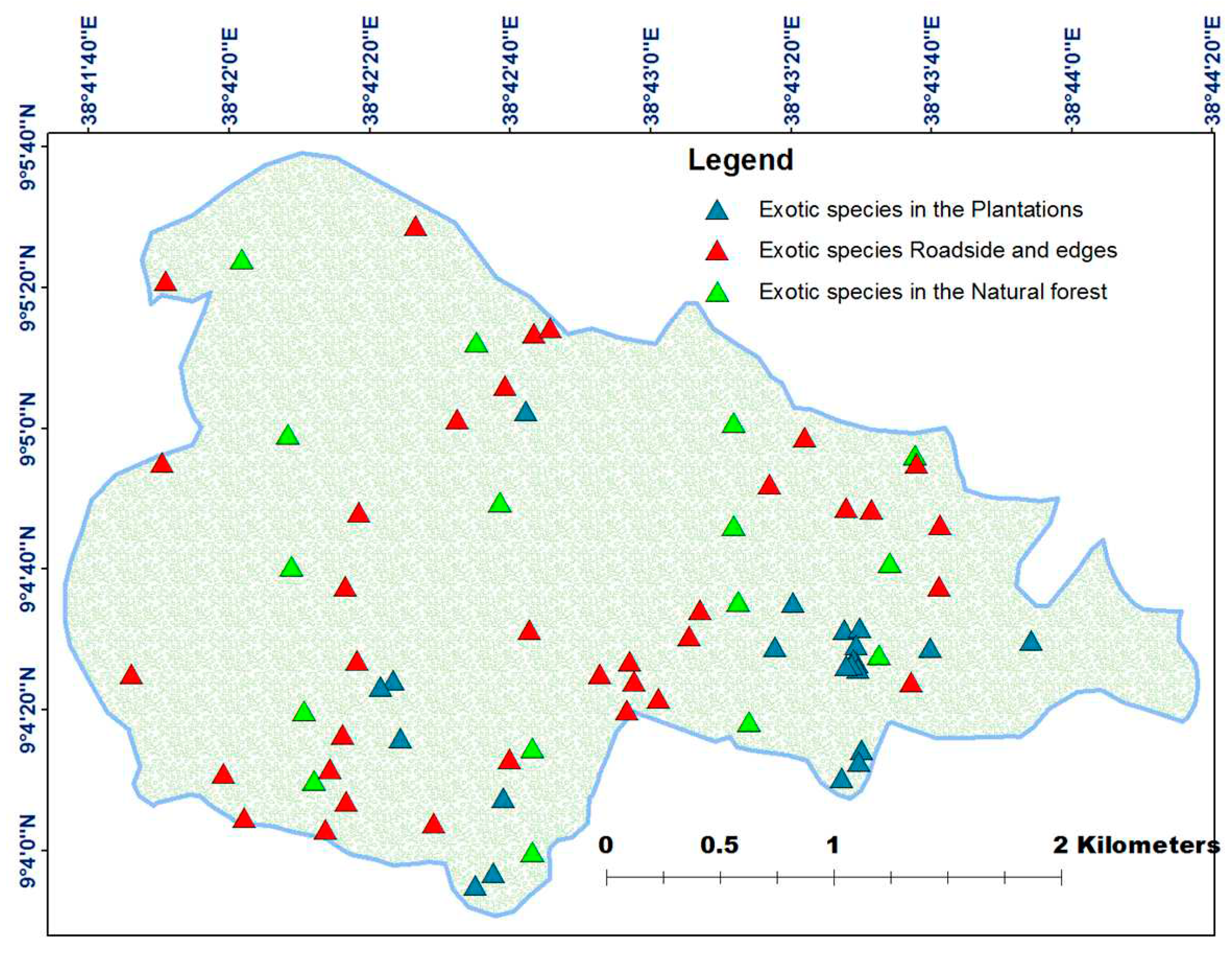
| Land use types | Abundance | Sampled area (m2) | Density (species/ m2) |
|---|---|---|---|
| Natural forest | 128 | 400 | 0.32 |
| Roadside and edges | 1045 | 725 | 1.44 |
| Plantation | 285 | 475 | 0.6 |
| Total | 1,458 | 1,600 | 2.36 |
| Community | Shannon-Wiener Diversity Index (H`) |
Shannon Evenness (J’) |
| Natural forest | 0.06 | 0.05 |
| Roadside and edges of the garden | 3.09 | 0.82 |
| Plantation | 0.63 | 0.29 |
| Land use type | Natural forest | Roadside and edges of the garden | Plantation |
| Natural forest | 1 | 0.22 | 0.15 |
| Roadside and edges of the garden | - | 1 | 0.40 |
| Plantation | - | - | 1 |
| No. | Species Name | Family | Habit | LUT found |
| 1 | Acacia decurrens Willd. | Fabaceae | T | NF,RE,PL |
| 2 | Acacia mearnsii De Wild. | Fabaceae | T | RE |
| 3 | Acacia melanoxylon R. Br. | Fabaceae | T | NF,RE,PL |
| 4 | Acacia saligna (Labill.) Wendl. | Fabaceae | S | NF,RE |
| 5 | Argemone mexicana L. | Papaveraceae | H | RE |
| 6 | Cuscuta campestris Yuncker | Cuscutaceae | H | NF,RE |
| 7 | Cyathula uncinulata (Schrad.) Schinz | Commelinaceae | H | NF,RE |
| 8 | Galinsoga parviflora Cav. | Asteraceae | H | PL |
| 9 | Lantana camara L. | Verbanaceae | S | NF,RE |
| 10 | Nerium oleander L. | Apocynaceae | S | RE,PL |
| 11 | Nicotiana glauca Graham | Solanaceae | S | RE |
| 12 | Psidium guajava L. | Myrtaceae | S | PL |
| 13 | Ricinus communis L. | Euphorbiaceae | S | RE,PL |
| 14 | Senna didymobotrya (Fresen.) Irwin & Barneby | Fabaceae | S | RE |
| 15 | Striga gesnerioides (Willd.) Vatke | Scrophulariaceae | H | RE,PL |
Disclaimer/Publisher’s Note: The statements, opinions and data contained in all publications are solely those of the individual author(s) and contributor(s) and not of MDPI and/or the editor(s). MDPI and/or the editor(s) disclaim responsibility for any injury to people or property resulting from any ideas, methods, instructions or products referred to in the content. |
© 2023 by the authors. Licensee MDPI, Basel, Switzerland. This article is an open access article distributed under the terms and conditions of the Creative Commons Attribution (CC BY) license (http://creativecommons.org/licenses/by/4.0/).





